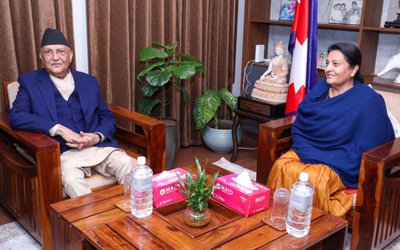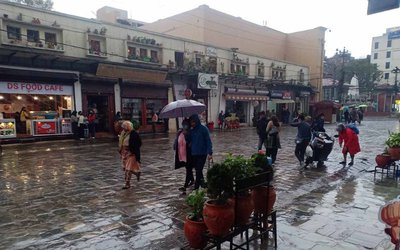
Although one may disagree with the various costs involved in Chameliya, no one will dispute about the value of the project as the first mega hydropower project under construction in the entire far western and mid-western region. Once the project starts power generation, it will naturally be a money minter in the region.
With a capacity of average 184.2 GWh hours annual generation, Chameliya, 30 MW project, will bring over Rs.1. 20 billion in Nepal Electricity Authority's coffers. Known for low Human Development Index, the far west will see Chameliya, with the 131 KM long, 132 KV transmission line from Balanch of Darchula to Baitadi, Dadeldhura, Doti and Attariya Kailali, transforming the entire life in the area.
The contract agreement was signed with China Gezuwa Water and Power Group Company in December 21, 2006 with an aim to complete the civil works by May 2011. Due to political trouble and major geological disturbance, squeezing of over 800 meter tunnel, the civil work was delayed and it was rescheduled for June 2013. Experts hold the view that this is the first kind of geological hazard any hydropower project faced in the South Asian region.
As the technical solution for the geological hazard has already been identified, it is just a matter of time to complete it. Similarly, the geological hazard appeared in the whole of the penstock increasing the estimated cost and time.
Along with the zoological hazard and other technical problems, removal of Keshab Raj Bhatta as a project manager, who had been involved in the project for 15 years by Energy Minister Prakash Sharan Mahat in 2010, also created certain managerial problem. Interestingly, the person who replaced Bhatta as a project manager returned from Baitadi Patan looking at the danger on the road.
Signed in April 30, 2009 with K.H.N.M.P Consortium Korea for electro-mechanical, hydro-mechanical and Balanch-Attariya 132 KV Transmission line, the contractor should have completed the project by May 2011. Due to political, financial and technical problems, it was extended till June 2013. Although the works in the hazard areas will take some time, the project will be delayed for one or two more years depending upon the timely decision and releasing of fund.
Initially the cost of the project was 99.9 million US dollars, which has now reached 158 million dollars due to political strikes, design change and geological hazard. Of course, the cost of the project has gone up. But it will start to produce the money once it generates the power.
The project was initiated after a strong commitment from Korean government's Economic Development Cooperation to provide a soft loan for 45 million US dollars for electromechanical, hydro mechanical and 132 KV Transmission Line through Korean Exim Bank. However, the recent delay in releasing the fund by Korean Exim Bank will push the project uncertainty.
Although over ninety-five percent of the civil work has already completed, the project is now facing a fund crisis. Any delay in decision making will definitely push the completion schedule behind by more years increasing the cost of the project as well as loss of revenue.
Due to the delay in payment from Korean Exim Ban, Korean Consultant Saman Corporation staff have not got even their salary of the last 15 months. They are supposed to get the payment of US dollars 548,452.65 from Korean Exim Bank as per the Interim Progress Report. In case Korean Exim Bank does not release the additional fund of 1.4 million rupees to complete additional penstock soon, the project will be further delayed as the monsoon is close to hit.
Chameliya, which is far from Kathmandu Load center and power center, got prominence when Nepal's political leaders competed to grab Toyota Prado vehicles imported for project sites. However, no one paid any attention to the project, even the leaders from far west, after that rush. The project had to wait for years to see the energy secretary at the site. Hari Ram Koirala, who was also posted as an administrator for far-western region for two years, made a record as the first Energy secretary to make an intensive tour of the project.
"Don't worry about the problems, this project must be completed by early 2014. NEA and country don't want to lose the money anymore," said secretary Koirala. "I am optimistic that the pace of construction will go fast now."
As the project is facing several complications at the last minute, energy secretary Koirala visited the site and extensively discussed about the problems. After discussions, secretary Koirala, who had led a three member team including Nepal Electricity Authority Board members Bibek Tated and Manoj Kumar Mishra, decided on 12 points to speed up the pace of project work. The decision includes working for the fund for additional penstock as demanded by Korean contractor KHNP. The secretary-led team also assured to raise the issue regarding the payment for Korean Consultant with Korean Exim Bank. The prolonged cost is demanded by KHNP consortium. The team directed to settle the issue related to variation II.
The team also directed the project manager to make the necessary arrangement for 843 meter long Tunnel Squeezing Treatment and the final cost estimated by consultant Shah/Silt/Icon, JV. It also extended the tenure of contractors and consultants.
"NEA has technical, managerial and other capabilities to deal with all kinds of problems in the project like Chameliya. As a citizen of Nepal and resident of Darchula district, I am hopeful that we will have light from the project soon," said Bhatta.
The sooner the project will complete, it will provide economic benefits to the people of Darchula and the far west. For this, release of funds from Korean Exim Bank is the key. "We are hopeful that Korean-Exim Bank will release the necessary fund," said Ram Chandra Pandey, general manager of NEA.

Keshab Poudel
Poudel is the editor of New Spotlight Magazine.
- KUL MAN GHISING: Bowing Down To The People
- Apr 13, 2025
- POLITICAL VIOLENCE: Culture of Impunity
- Apr 11, 2025
- PM OLI MEETS PM MODI: No Progress
- Apr 09, 2025
- PM OLI’S THAILAND VISIT: Flip Flop
- Apr 08, 2025
- FM Dr. Deuba’s India Visit: Mission Aborted
- Mar 26, 2025














